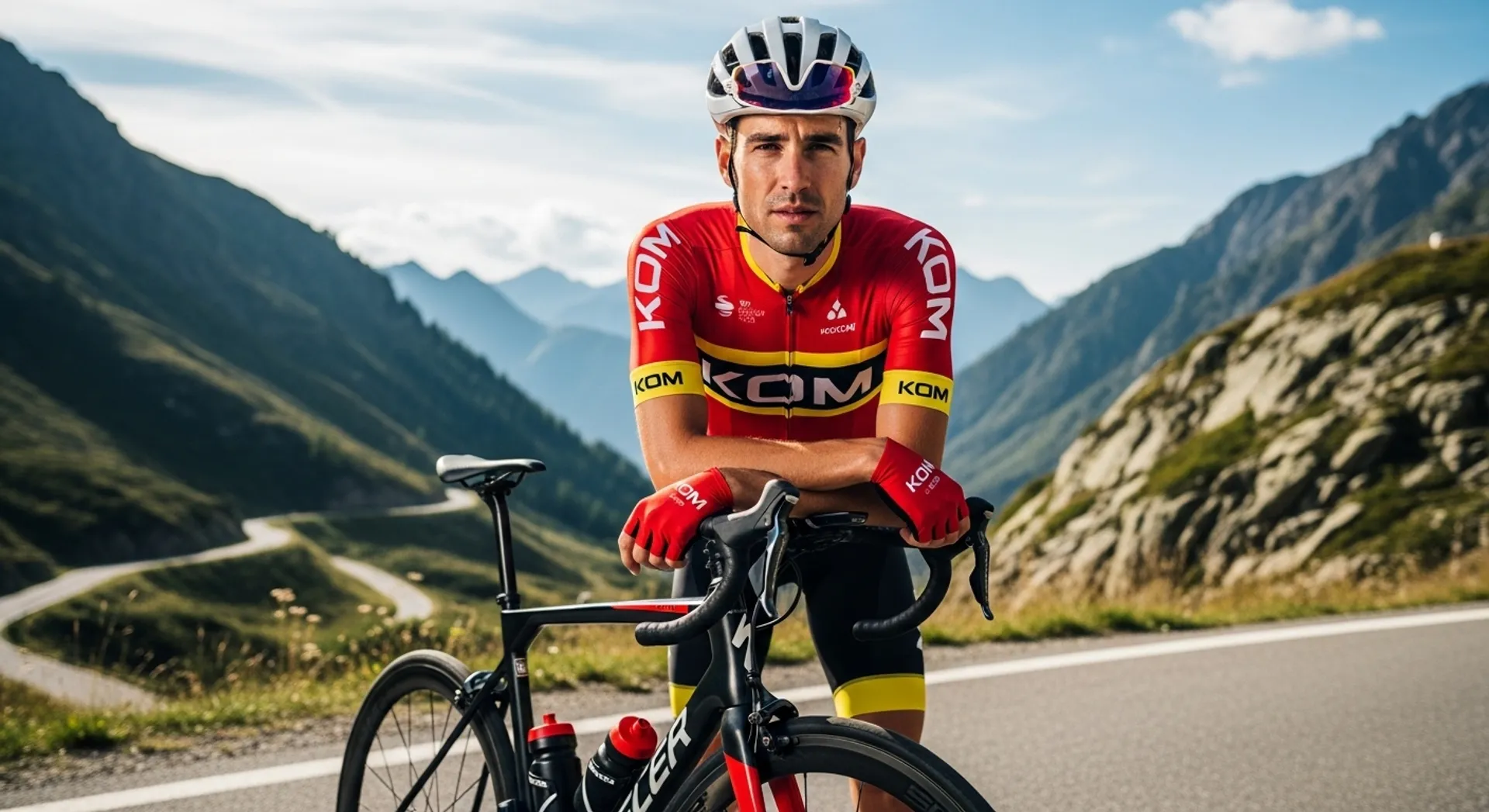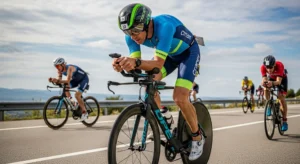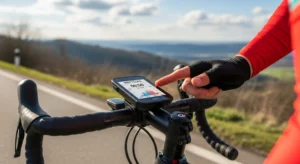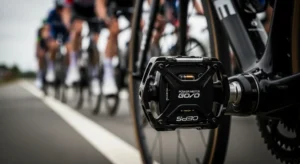Meet Lynn Wilkirson of Los Angeles, California — a full-time sales professional, Navy veteran, and dedicated King of the Mountain competitor. While he may not have won the polka dot jersey in the Tour de France, Lynn is no less a competitor than legendary climber Richard Virenque. He represents a rapidly growing population of athletes who are discovering that you don’t need to be a professional cyclist to benefit dramatically from power meter training.
Lynn’s story is one that resonates with countless amateur cyclists who juggle full-time careers, family responsibilities, and a passion for cycling performance. Through strategic training with power meters, these athletes are achieving fitness levels and completing challenges that would have seemed impossible just years ago. His journey from casual Navy cyclist to King of the Mountain finisher demonstrates the transformative potential of data-driven training for everyday riders.
iBikeBlog recently had the honor of catching up with Lynn to understand his approach to training, why he chooses to ride with power, and how technology has enabled him to tackle some of cycling’s most brutal challenges. His insights offer valuable lessons for any cyclist looking to take their riding to the next level, regardless of age, experience, or professional status.
From Navy Sailor to Cycling Enthusiast
Lynn’s introduction to cycling began in 1987 during his service in the United States Navy. Stationed in Hawaii — a location that would inspire anyone to get outdoors — he noticed a couple of fit colleagues at work and felt motivated to join them. After purchasing his first bicycle, Lynn started riding and immediately connected with the sport. That initial spark ignited a passion that has burned continuously for over three decades.
“I saw a couple of fit guys at work and bought my first bike. I started riding and the rest is history,” Lynn recalls with characteristic modesty. “I’ve been riding ever since.” What began as a simple fitness activity evolved into a lifelong commitment to cycling across multiple disciplines and increasingly challenging events.
The beauty of Lynn’s story lies in its accessibility. He didn’t grow up racing bicycles or dreaming of professional cycling contracts. He discovered the sport as an adult, driven by the simple desire to improve his fitness and connect with like-minded individuals. This narrative mirrors the experience of countless cyclists who find the sport later in life and discover an unexpected passion for structured training and performance improvement.
Why Amateur Athletes Train With Power
One of the most common misconceptions about power meter training is that it’s only valuable for professional cyclists or serious triathletes. Lynn’s experience thoroughly debunks this myth. As a full-time sales professional without sponsorships or professional racing ambitions, he represents the typical power meter user — someone who wants to maximize their limited training time and achieve specific performance goals.
“I started training with power meters to increase my fitness and to take my cycling to new levels,” Lynn explains. “My power meter really keeps me focused on increasing my power outputs on my training rides.” This focus transforms random miles into purposeful training sessions, where every ride has specific objectives tied to measurable improvements.
The psychological benefit of having concrete, objective data cannot be overstated. Unlike perceived exertion or even heart rate, which can be influenced by factors like caffeine, stress, sleep quality, or temperature, power output provides unfiltered feedback about your actual work rate. For busy professionals like Lynn who might only have a few hours per week to train, this efficiency is invaluable.
Measurable Results and Performance Gains
When asked about tangible improvements from power-based training, Lynn’s response highlights the real-world benefits that matter to amateur cyclists: “By using the iBike power meter, I’ve noticed gains in fitness and power through the fitness tests. I’ve also gained knowledge of what power level I can maintain for different types of riding.”
This knowledge — understanding your sustainable power levels for different ride durations and intensities — forms the foundation of effective pacing strategy. Whether you’re attempting a century ride, a gran fondo, or a multi-day climbing challenge, knowing how hard you can push without blowing up makes the difference between success and disappointment.
For Lynn, power meter data revealed specific fitness improvements over time. Periodic fitness tests showed his functional threshold power increasing, his power-to-weight ratio improving, and his ability to sustain higher outputs for longer durations expanding. These aren’t abstract numbers — they translate directly into climbing faster, maintaining pace in group rides, and completing ambitious challenges that once seemed beyond reach.
The Power of Affordable Technology
Cost often presents the biggest barrier to entry for cyclists interested in power-based training. Professional-grade power meters can cost thousands of dollars, putting them out of reach for many amateur athletes. Lynn’s choice to use iBike power meters reflects a practical approach to accessing this technology without breaking the bank.
“I’ve had an iBike since the first generation was introduced,” Lynn notes. “I chose iBike power meters because they are affordable and because of their ability to move to all my other bicycles — all five of them: road bike, cyclocross, TT bike, mountain bike, and tandem.”
This versatility factor cannot be overlooked. Many cyclists own multiple bikes for different disciplines or conditions. Traditional crank-based or pedal-based power meters require separate units for each bike, potentially multiplying costs by thousands of dollars. The ability to move one power meter across multiple bikes democratizes access to power-based training for multi-discipline cyclists.
The Value of Comprehensive Data Analysis
Beyond the hardware itself, Lynn appreciates the analytical capabilities of accompanying software: “I also like the information that the Isaac ride analysis software provides.” Modern ride analysis platforms transform raw power data into actionable insights about your training stress, fitness progression, form, and fatigue levels.
This software helps answer critical questions that every serious cyclist asks: Am I training too hard or not hard enough? How much fitness have I gained this month? Am I ready for my goal event? What’s my optimal training load? Without sophisticated analysis tools, power data remains just numbers on a screen rather than a roadmap for improvement.
The combination of affordable hardware and comprehensive software creates an accessible ecosystem for amateur athletes. Lynn’s multi-bike setup — spanning road, cyclocross, time trial, mountain, and even tandem disciplines — demonstrates that power-based training isn’t limited to a single type of cycling. The principles of training with power apply universally across cycling disciplines.
The Joy of Cycling Beyond Competition
When asked about his favorite feeling on the bike, Lynn’s response reveals a mature perspective on cycling that many riders develop over decades in the sport: “I just like riding and being healthy. I also like to conquer the challenges that come with all the different types of events.”
This attitude — valuing health, enjoyment, and personal challenges over podium positions — represents a sustainable approach to lifelong cycling. While power meters and structured training help Lynn achieve impressive performances, they serve a larger purpose of maintaining fitness, mental health, and quality of life as he navigates the demands of a busy professional career.
The variety in Lynn’s riding — from road racing to cyclocross to mountain biking to tandem riding — prevents burnout and keeps the sport fresh. Each discipline presents unique challenges and requires different physical and technical skills. Power meters provide a common language across all these disciplines, allowing Lynn to train effectively regardless of which bike he’s riding.
Conquering the King of the Mountain Challenge
When discussing memorable rides, Lynn immediately references the King of the Mountain Challenge — an event that would test even the most seasoned professional cyclists. This brutal multi-day challenge consists of three separate rides that must be completed within strict time limits, covering a combined 334 miles with approximately 37,000 feet of climbing.
To put those numbers in perspective, 37,000 feet of elevation gain exceeds the height of Mount Everest measured from sea level. Spread across 334 miles, the challenge demands not just climbing prowess but also endurance, pacing strategy, and mental fortitude. The second stage famously features a grim reaper mascot waiting at the final climb — a darkly humorous reminder of the challenge’s difficulty.
Completing the King of the Mountain Challenge represents a monumental achievement for any cyclist, professional or amateur. For Lynn, success in this event validates years of disciplined training guided by power meter data. The ability to pace himself across three stages, knowing exactly how hard he could push on each climb without exceeding his limits, came directly from his experience training with power.
The Role of Power Data in Extreme Challenges
Events like the King of the Mountain Challenge aren’t won with raw fitness alone — they require intelligent pacing and energy management. Power meters excel in these scenarios by providing real-time feedback about effort levels. Lynn could monitor his output on early climbs to ensure he wasn’t digging too deep, preserving enough energy to complete all three stages within the time cutoffs.
The mental benefit of having concrete data during extreme efforts also matters tremendously. When fatigue sets in and your mind starts questioning whether you can continue, objective power numbers help distinguish between genuine physical limits and temporary discomfort. If your power meter shows you’re still producing watts near your target zones, you know you have more to give despite the suffering.
Lessons for Everyday Cyclists
Lynn’s journey offers several valuable lessons for cyclists at any level. First, age and professional status don’t determine your potential for improvement. Lynn started cycling in his late twenties and has continued progressing into his forties and beyond, proving that consistent training produces results regardless of when you start.
Second, structured training with objective data dramatically accelerates progress compared to simply riding for miles without specific goals. Lynn’s fitness gains came from focused efforts guided by power meter feedback, not from mindlessly accumulating saddle time.
Third, investing in quality training tools pays dividends over time. While power meters represent a significant initial expense, the performance improvements and training efficiency they enable provide value for years. Lynn’s use of the same power meter system across multiple bikes over many years demonstrates excellent return on investment.
Fourth, setting ambitious goals — even ones that seem beyond your current capabilities — provides powerful motivation for consistent training. The King of the Mountain Challenge likely seemed impossible to Lynn when he first started cycling. Through years of progressive training, what once seemed impossible became achievable.
Training Tips from a Veteran Power User
Based on Lynn’s experience with power-based training, several practical tips emerge for cyclists looking to incorporate power meters into their training:
Conduct regular fitness tests to track your functional threshold power and monitor progress over time. Lynn specifically mentions using fitness tests to document his gains — this objective measurement prevents you from relying on subjective feelings that may not reflect reality.
Learn your sustainable power levels for different ride durations. Lynn emphasizes gaining “knowledge of what power level I can maintain for different types of riding.” This self-knowledge comes from analyzing ride data and noting which power levels you can sustain for one hour, two hours, four hours, and so on.
Use your power meter across all cycling disciplines, not just road riding. Lynn’s success in events like the King of the Mountain Challenge came partly from his varied training across multiple bike types and terrains. Each discipline builds different strengths that transfer to others.
Focus on the process of training rather than obsessing over immediate results. Lynn’s comment about “just liking riding and being healthy” reflects a sustainable mindset that keeps him training consistently year after year. The performance gains follow naturally from this consistency.
The Future of Amateur Cycling Performance
Lynn Wilkirson represents the future of amateur cycling — athletes who leverage professional-level training technology and knowledge to achieve extraordinary performances while maintaining full-time careers and balanced lives. As power meters become more affordable and user-friendly, more cyclists like Lynn will access the benefits of data-driven training.
His story also highlights how cycling’s community and technology have evolved. The same training methods that once belonged exclusively to professional teams are now available to anyone willing to invest in the hardware and commit to structured training. This democratization of performance cycling knowledge raises the level of amateur competition and pushes the boundaries of what recreational athletes can achieve.
Looking forward, we can expect to see more amateur cyclists completing challenges that would have been considered professional-level efforts just a generation ago. As training methods improve and technology becomes more sophisticated, the gap between amateur and professional performance continues to narrow — not because professionals are slowing down, but because amateurs are getting dramatically faster.
Conclusion: The Power of Purpose-Driven Training
Lynn Wilkirson’s cycling journey exemplifies how ordinary cyclists can achieve extraordinary results through purpose-driven training. From his beginnings as a Navy sailor buying his first bike in Hawaii to his completion of one of cycling’s most brutal climbing challenges, Lynn’s progression demonstrates the transformative potential of consistent training guided by objective data.
His choice to train with power meters wasn’t about chasing professional contracts or sponsorships — it was about personal improvement, health, and the satisfaction of conquering difficult challenges. This motivation resonates with the vast majority of cyclists who ride not for money or fame, but for personal fulfillment and the joy of testing their limits.
The accessibility of Lynn’s story matters. He’s not genetically gifted or blessed with unlimited training time. He’s a working professional who maximizes limited training hours through intelligent use of technology. His success proves that with the right tools, consistent effort, and clear goals, any dedicated cyclist can achieve performances that once seemed reserved for elite athletes.
Full salute to you, Lynn, for your service to our country and your inspiring dedication to cycling excellence. Your completion of the King of the Mountain Challenge stands as testament to the power of data-driven training and the human capacity for continuous improvement. Keep up the outstanding work and keep inspiring the rest of us to chase our own ambitious cycling goals.
Do you have questions about weight loss, nutrition, or training with power meters? We’d love to hear from you. Please contact iBikeBlog and share your own cycling journey. Thank you for reading!




